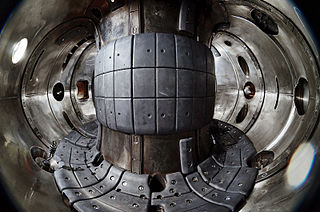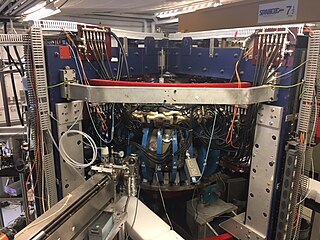
A tokamak is a device which uses a powerful magnetic field to confine plasma in the shape of a torus. The tokamak is one of several types of magnetic confinement devices being developed to produce controlled thermonuclear fusion power. As of 2016, it was the leading candidate for a practical fusion reactor. The word "tokamak" is derived from a Russian acronym meaning "toroidal chamber with magnetic coils".

In plasma physics, plasma stability concerns the stability properties of a plasma in equilibrium and its behavior under small perturbations. The stability of the system determines if the perturbations will grow, oscillate, or be damped out. It is an important consideration in topics such as nuclear fusion and astrophysical plasma.
A Langmuir probe is a device used to determine the electron temperature, electron density, and electric potential of a plasma. It works by inserting one or more electrodes into a plasma, with a constant or time-varying electric potential between the various electrodes or between them and the surrounding vessel. The measured currents and potentials in this system allow the determination of the physical properties of the plasma.
Plasma diagnostics are a pool of methods, instruments, and experimental techniques used to measure properties of a plasma, such as plasma components' density, distribution function over energy (temperature), their spatial profiles and dynamics, which enable to derive plasma parameters.

The Levitated Dipole Experiment (LDX) was an experiment investigating the generation of fusion power using the concept of a levitated dipole. The device was the first of its kind to test the levitated dipole concept and was funded by the US Department of Energy. The machine was also part of a collaboration between the MIT Plasma Science and Fusion Center and Columbia University, where another (non-levitated) dipole experiment, the Collisionless Terrella Experiment (CTX), was located.

Magnetic confinement fusion (MCF) is an approach to generate thermonuclear fusion power that uses magnetic fields to confine fusion fuel in the form of a plasma. Magnetic confinement is one of two major branches of controlled fusion research, along with inertial confinement fusion.
The polywell is a proposed design for a fusion reactor using an electric and magnetic field to heat ions to fusion conditions.
An edge-localized mode (ELM) is a plasma instability occurring in the edge region of a tokamak plasma due to periodic relaxations of the edge transport barrier in high-confinement mode. Each ELM burst is associated with expulsion of particles and energy from the confined plasma into the scrape-off layer. This phenomenon was first observed in the ASDEX tokamak in 1981. Diamagnetic effects in the model equations expand the size of the parameter space in which solutions of repeated sawteeth can be recovered compared to a resistive MHD model. An ELM can expel up to 20 percent of the reactor's energy.

Plasma is one of four fundamental states of matter characterized by the presence of a significant portion of charged particles in any combination of ions or electrons. It is the most abundant form of ordinary matter in the universe, mostly in stars, but also dominating the rarefied intracluster medium and intergalactic medium. Plasma can be artificially generated, for example, by heating a neutral gas or subjecting it to a strong electromagnetic field.
The GLAss Spherical Tokamak is a name given to a set of small spherical tokamaks located in Islamabad, Pakistan. They were developed by the Pakistan Atomic Energy Commission (PAEC) as part of the National Tokamak Fusion Program (NTFP) in 2008 and are primarily used for teaching and training purposes.

COMPASS, short for Compact Assembly, is a compact tokamak fusion energy device originally completed at the Culham Science Centre in 1989, upgraded in 1992, and operated until 2002. It was designed as a flexible research facility dedicated mostly to plasma physics studies in circular and D-shaped plasmas.

The Hybrid Illinois Device for Research and Applications (HIDRA) is a medium-sized toroidal magnetic fusion device housed in the Nuclear Radiation Laboratory and operated by the Center for Plasma-Material Interactions (CPMI) within the Department of Nuclear, Plasma and Radiological Engineering at the University of Illinois at Urbana–Champaign, United States. HIDRA had its first plasma at the end of April 2016 and started experimental campaigns by December of that year. HIDRA is the former WEGA classical stellarator that was operated at the Max Planck Institute for Plasma Physics in Greifswald Germany from 2001 to 2013.
High-confinement mode, or H-mode, is an operating regime possible in toroidal magnetic confinement fusion devices – mostly tokamaks, but also in stellarators. In this regime the plasma has a higher energy confinement time.
Jose A. Boedo is a Spanish plasma physicist and a researcher at University of California, San Diego. He was elected as a fellow of the American Physical Society in 2016 for "his ground-breaking contributions to the studies of plasma drifts and intermittent plasma transport in the peripheral region of tokamaks".
Hartmut Zohm is a German plasma physicist who is known for his work on the ASDEX Upgrade machine. He received the 2014 John Dawson Award and the 2016 Hannes Alfvén Prize for successfully demonstrating that neoclassical tearing modes in tokamaks can be stabilized by electron cyclotron resonance heating, which is an important design consideration for pushing the performance limit of the ITER.
Noah Hershkowitz was an American experimental plasma physicist. He was known for his pioneering research on the understanding of plasma sheaths, solitons and double layers in plasmas, as well as the development of the emissive probe which measures the plasma potential.
Keith Howard Burrell is an American plasma physicist.
Friedrich E. Wagner is a German physicist and emeritus professor who specializes in plasma physics. He was known to have discovered the high-confinement mode of magnetic confinement in fusion plasmas while working at the ASDEX tokamak in 1982. For this discovery and his subsequent contributions to fusion research, was awarded the John Dawson Award in 1987, the Hannes Alfvén Prize in 2007 and the Stern–Gerlach Medal in 2009.

The Tokamak Chauffage Alfvén Brésilien (TCABR) is a tokamak situated at the University of Sao Paulo (USP), Brazil. TCABR is the largest tokamak in the southern hemisphere and one of the magnetic-confinement devices committed to advancing scientific knowledge in fusion power.
Low to High Confinement Mode Transition, more commonly referred to as L-H transition, is a phenomenon in the fields of plasma physics and magnetic confinement fusion, signifying the transition from less efficient plasma confinement to highly efficient modes. The L-H transition, a milestone in the development of nuclear fusion, enables the confinement of high-temperature plasmas. The transition is dependent on many factors such as density, magnetic field strength, heating method, plasma fueling, and edge plasma control, and is made possible through mechanisms such as edge turbulence, E×B shear, edge electric field, and edge current and plasma flow. Researchers studying this field use tools such as Electron Cyclotron Emission, Thomson Scattering, magnetic diagnostics, and Langmuir probes to gauge the PLH and seek to lower this value. This confinement is a necessary condition for sustaining the fusion reactions, which involve the combination of atomic nuclei, leading to the release of vast amounts of energy.


























